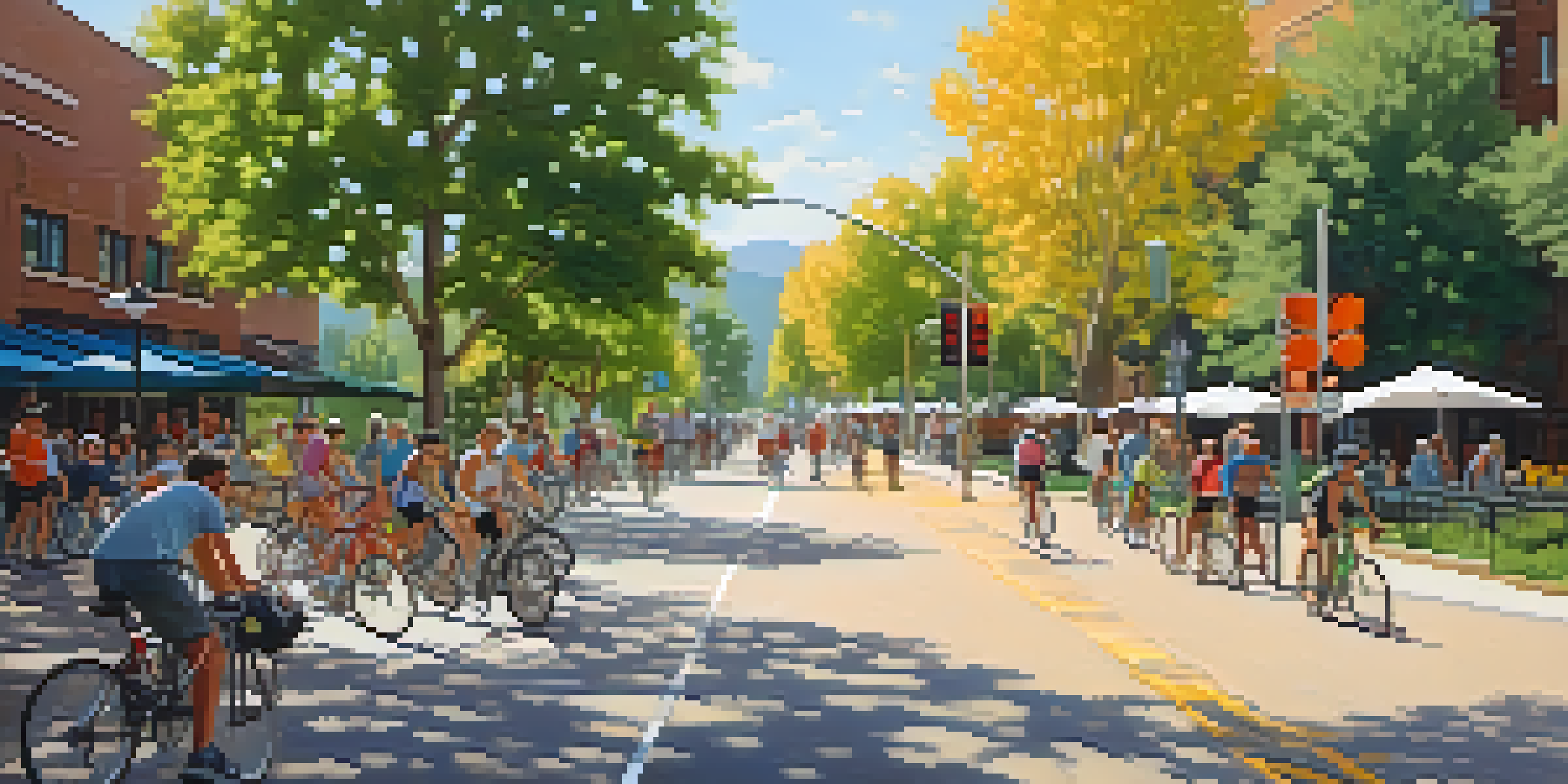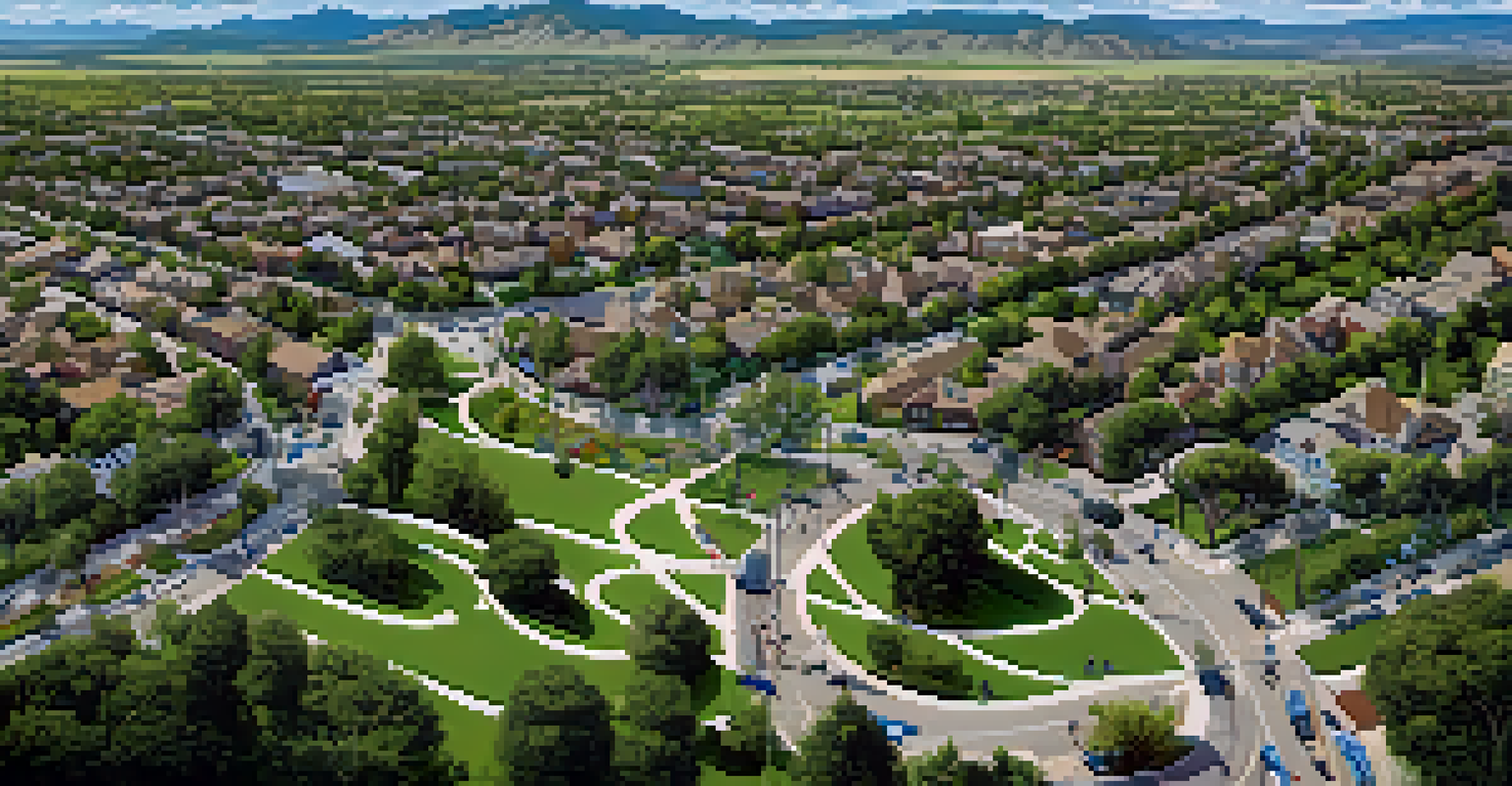Boulder's Bicycle Infrastructure: A Model for Other Cities

Boulder's Vision for Bicycle-Friendly Urban Planning
Boulder, Colorado, has long been recognized for its commitment to sustainable transportation. The city’s vision embraces cycling as a primary mode of transport, integrating it into their urban planning. This proactive approach is evident in their comprehensive bicycle master plan, which aims to create a connected network for cyclists throughout the city.
Cycling is one of the most sustainable forms of transportation, benefiting both the environment and the community.
By prioritizing bike-friendly infrastructures, such as dedicated lanes and bike-sharing programs, Boulder has made cycling accessible for everyone. The city understands that making cycling convenient encourages residents to opt for bikes over cars, thus reducing traffic congestion and pollution. This vision is not just about infrastructure; it’s about fostering a culture that values cycling as a viable transportation option.
Other cities can learn from Boulder’s example by adopting similar policies that prioritize cycling. By investing in bicycle infrastructure and promoting a bike-friendly culture, urban planners can create healthier, more sustainable cities that benefit everyone.
A Comprehensive Bicycle Network: Connecting the City
One of Boulder’s standout features is its extensive and well-planned bicycle network. The city boasts over 300 miles of paved and unpaved trails, ensuring cyclists can navigate easily and safely. This network connects key areas, including residential neighborhoods, schools, and commercial districts, making it easy for cyclists to reach their destinations.

Moreover, Boulder's commitment to maintaining and improving these trails is evident in their ongoing investment in infrastructure. Regular upgrades and repairs ensure that pathways are safe and enjoyable for all users. The city also collaborates with various organizations to promote cycling events and initiatives, further enhancing community engagement.
Boulder's Bicycle Infrastructure Success
Boulder's extensive bike network and infrastructure promote cycling as a primary mode of transport, encouraging sustainable urban living.
Cities looking to replicate Boulder's success should focus on creating a comprehensive network that prioritizes connectivity and safety. By ensuring that all parts of the city are accessible by bike, urban planners can encourage more residents to choose cycling over driving.
Safety First: Boulder's Approach to Cyclist Protection
Safety is a critical component of any bicycle infrastructure, and Boulder has implemented several measures to protect cyclists. The city has installed traffic signals specifically designed for cyclists, along with dedicated bike lanes that separate cyclists from vehicular traffic. These safety features are vital in promoting a more secure cycling environment.
A bicycle is the simplest tool for the most complex problems, from traffic congestion to pollution.
In addition to physical infrastructure, Boulder emphasizes education and awareness campaigns aimed at both cyclists and drivers. These initiatives educate users about road sharing and the importance of following traffic laws. By fostering understanding between all road users, Boulder has created a more harmonious cycling culture.
Other cities can benefit from adopting similar safety measures and educational programs. Enhancing cyclist safety not only encourages more people to ride bikes but also contributes to a positive perception of cycling in the community.
Innovative Bike Parking Solutions in Boulder
Boulder understands that providing adequate bike parking is crucial to encouraging cycling. The city has implemented a variety of innovative bike parking solutions, including covered bike racks, bike lockers, and secure bike stations. These options cater to cyclists' different needs, ensuring they have a safe place to leave their bikes.
Additionally, Boulder has integrated bike parking into public transportation hubs, making it easy for cyclists to transition between biking and using buses or trains. This integration supports a multi-modal transportation system that maximizes convenience for users. The aim is to make cycling an attractive option for commuters without sacrificing the security of their bikes.
Community Engagement Drives Cycling
Active community involvement in cycling initiatives fosters a supportive culture that encourages more residents to embrace biking.
Cities aiming to enhance their bicycle infrastructure should consider investing in diverse bike parking options. Providing secure and accessible bike parking encourages more residents to embrace cycling as a part of their daily routines.
Community Engagement: Building a Cycling Culture
Boulder's success as a cycling city is rooted in strong community engagement. The city organizes numerous events, such as bike-to-work days and community rides, to promote cycling as a fun and healthy activity. These events help foster a sense of community among cyclists and encourage those who may be hesitant to try cycling.
Moreover, Boulder actively seeks feedback from residents regarding cycling infrastructure and initiatives. By involving the community in decision-making processes, the city ensures that their cycling policies reflect the needs and desires of the people. This transparency builds trust and encourages more residents to participate in cycling.
Other cities should take note of Boulder's commitment to community engagement. By involving residents in the conversation about cycling, cities can create a supportive environment that encourages more people to take up cycling.
Environmental Benefits of Boulder's Cycling Initiatives
Boulder's emphasis on cycling goes beyond transportation; it has significant environmental benefits as well. By promoting cycling, the city reduces greenhouse gas emissions and helps improve air quality. Fewer cars on the road mean less pollution, which contributes to a healthier environment for everyone.
Furthermore, Boulder's bike-friendly initiatives promote the use of green spaces and trails, encouraging residents to enjoy the natural beauty of the area. This connection to nature enhances the overall quality of life and encourages outdoor activities. It’s a win-win situation for both residents and the environment.
Economic Benefits of Cycling
Boulder's bike-friendly policies boost local economies by increasing business sales and attracting tourism.
Cities interested in sustainability should consider how cycling can play a role in their environmental strategies. By investing in bicycle infrastructure, cities can make impactful strides towards reducing their carbon footprint.
The Economic Impact of Boulder's Bicycle Infrastructure
Boulder's commitment to cycling also has notable economic benefits. Studies show that cities with robust bicycle infrastructure experience increased local business sales, as cyclists tend to frequent local shops and cafes. This boost in business can significantly contribute to the local economy, making cycling not just an environmental choice but an economic one as well.
Additionally, the city attracts tourists who are drawn to its bike-friendly reputation. Events like cycling festivals and races bring visitors from all over, providing an influx of revenue to local businesses. By promoting cycling, Boulder has positioned itself as a desirable destination for both residents and tourists.

Other cities can harness the economic potential of cycling by investing in their infrastructure. By recognizing the connection between cycling and economic growth, cities can create a thriving environment that benefits everyone.